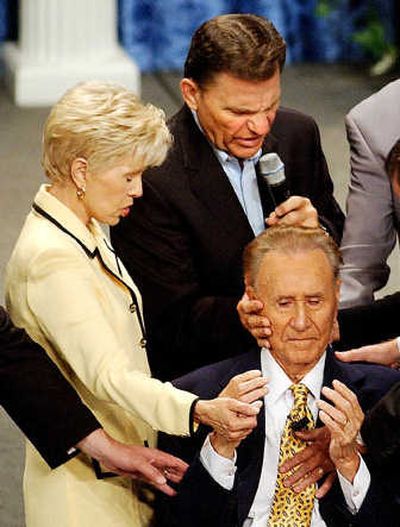GODLY SUMS OF MONEY

WASHINGTON – Twenty years ago, amid an uproar over the sex-and-money scandal that brought down televangelist Jim Bakker, the country’s leading TV preachers were called before a powerful House panel to testify about their financial dealings.
“People … need to know what their money is being used for – is it being used for the Lord’s work or is it being used to buy a million dollar house?” asked then-Rep. Byron Dorgan, D-N.D.
That furor quickly fizzled.
Congress passed no new laws. The IRS, which oversees tax-exempt ministries, got no new powers, money or agents.
Now, the same line of questioning looms for a new generation of televangelists.
A congressional investigation into the finances of six media-oriented ministries comes as megachurches have flourished. Since the scandals in the 1980s, televangelists’ revenue and reach have grown exponentially.
But even as media ministry has become a billion-dollar industry, it has continued to operate with little or no government oversight, critics say. An overburdened IRS and wary lawmakers have tread lightly in the face of growing questions about the financial operations of powerful and popular preachers.
“There’s no accountability,” said Ole Anthony, president of Trinity Foundation, a ministry watchdog group. “None, zero.”
That void, said Sen. Charles Grassley, R-Iowa, is part of what prompted him to act last week when he requested extensive information about the salaries, expense accounts and business practices of the TV evangelists.
Grassley, the ranking Republican on the Senate Finance Committee, said he was disturbed by reports about preachers living lavishly – driving Rolls-Royces and flying around in private jets – as their tax-exempt church finances escaped scrutiny.
“The IRS hasn’t been doing their job with nonprofits,” Grassley said. “We have a responsibility to review the laws and make a determination” about whether the rules are adequate and whether they are being properly followed and enforced.
Ministers targeted in Grassley’s inquiry said last week that they fully comply with the law and operate with integrity.
Under federal law, churches get tax-exempt status and don’t have to report financial data to the government as other nonprofits do. The law prohibits leaders and founders of such ministries from dipping into the organizations’ accounts for personal use, and a pastor’s compensation must be “reasonable”; expenses of tax-exempt groups are supposed to further their causes.
Grassley said he won’t know what the next step is until after Dec. 6, the deadline for the ministries to provide his Finance Committee staff with the requested information. The panel could then hold hearings, craft new rules for churches or work with the ministries on internal reform.
Two decades after the fall of Bakker and others, televangelism is a booming enterprise.
“The size (of congregations) continues to grow, and so does the income and the scope of their ministries,” said Scott Thumma, a professor at the Hartford Institute for Religion Research and author of “Beyond Megachurch Myths.”
Thumma said there are about 1,250 megachurches in the United States, up from 310 in 1990, and some have congregations well over 10,000. In 2005, such churches had an average income of $6 million a year, up from about $4.5 million just five years earlier, he said.
The growth of such ministries has been fueled in part by religious cable networks. And they don’t limit themselves to TV.
“They now have publishing companies, they have movie companies, they have recording studios that maybe 20 years ago” were not part of a televangelist’s portfolio, said Grassley.
Many of the ministries set up their own internal governing boards, but critics say those are sometimes stocked with family members or friends.
As media-oriented ministries have mushroomed, the IRS hasn’t been able to keep up.
The IRS doesn’t keep data on how many churches are in the U.S. But in 2006, there were about 1.5 million nonprofit 501(c)(3) groups, the section of the tax code that applies to churches.
That number keeps climbing, with nearly 100,000 nonprofits added to the IRS’ rolls in the last three years.
“They just don’t have the manpower,” Anthony said. The law is “meaningless” because no one is enforcing it, he said.
Politicians have not rushed to fill this vacuum.
Observers say it’s no surprise that Congress is reluctant to act. Lawmakers don’t want to take steps that might anger or alienate a key segment of the electorate. Nor do they want to do anything that appears to blur the separation of church and state.
“A lot of legislators just don’t want to take on religious groups … so they have been able to operate under pretty lax oversight or no oversight,” said William Martin, a religion scholar at Rice University’s James A. Baker III Institute for Public Policy.
Indeed, religion experts said Grassley’s move is surprising and could put him in an uncomfortable spot.
“That’s a large step for the government to take and potentially a kind of slippery slope as to where it’s going to stop,” said Thumma.
If Grassley wonders what kind of criticism he may be in for, the 1987 House hearing – the only congressional session on the subject in the last two decades – may provide a hint.
The head of the National Religious Broadcasters association called that hearing “the beginning of a new inquisition” against televangelists.